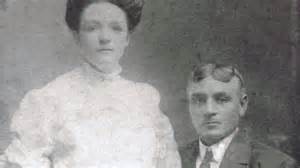Ireland's Great Loss - Titanic Honeymoons Part XII
/In July 1905, twenty-six-year-old Kate McHugh arrived at Ellis Island with $15.00 in her pocket and the hope of a better life in Chicago than back home in County Mayo, Ireland. A cousin and other relatives had gone to Chicago before her, and she was able to find work. But five years later, Kate was still single. She decided to return to Ireland for a visit and perhaps see if her old friend, John Bourke, was still a bachelor. John, ten years older than Kate and forty-one by this time, had, indeed, never married. The two began courting and were married in 1911, with plans to live on John’s farm. But Kate missed the excitement of Chicago. When another cousin, Catherine McGowan, returned from a visit to the United States, she urged Kate and John to sell the farm and come back with her and her 15-year-old niece on Titanic.
John and Kate Bourke
The Bourkes were persuaded to follow the dream of thousands of others who'd left Ireland. With money from selling the farm, they could start a small business. John purchased two tickets in Titanic's third class. John’s sister chose to join the group as well. In all, fourteen men and women from the area booked passage on Titanic. John and Kate were the oldest and 15-year-old Annie McGowan the youngest. The rest were in their 20s. A “live wake” was given in their honor, a customary sendoff for emigrants to America. Folks wished them well, but no one knew when, or if, they would ever see each other again.
Passengers waiting to board Titanic at Queenstown, Ireland
Aboard the Titanic on the night of April 14, the County Mayo group had all gone to bed after a night of singing and dancing in the third class public rooms. They slept through the collision, but when the engines stopped, John Bourke awoke. He could hear steam releasing, so he went to check with a steward who told him the ship had struck something but there was no danger. Still concerned, he woke the others and gathered them together. Kate led them in prayer.
At 12:15 am, a steward told the group to go up on deck. Some had already dressed, while others pulled coats over their nightclothes. A crowd filled the passageway, but officers now told them to wait. John led Kate, his sister, and two others off to find a ladder he had seen that led to the upper decks. Reaching the boat deck, Kate and John’s sister were given spots in Lifeboat 16, but jumped out when John was not allowed to board. Annie Kelly, another girl in their party who had wandered up to the boat deck on her own, was given their place.
Through the night, after the Titanic sank and those in the boats waited for rescue, Annie thought she was the only one of the County Mayo group to have survived. Then with the light of dawn, she discovered Annie McGowan in the lifeboat with her. Once in New York, they were admitted to a hospital for treatment of shock and exposure.
Some survivors claimed John Bourke and another man from their group helped several other passengers from third class reach the boat deck. Neither John’s nor Kate’s body was ever found.
The devastating news of the sinking soon reached Ireland, while names of survivors trickled in. The families waited and prayed, until it appeared that Annie Kelly and Annie McGowan were the only survivors from the 14-member County Mayo contingent. John Bourke’s tiny village, with a population of only 61, lost not only him but five young women.
Then a third passenger from the group, Delia McDermott, was counted among the survivors. While the lifeboats were loading, Delia had gone back down to her cabin at the last minute to retrieve her new hat. Back on deck, a steward helped her board Lifeboat 13. Following rescue, she stayed in New York rather than head for Chicago as she had planned. Somehow, the press missed adding her to the survivor lists until several days later.
Memorial dedication to the eleven Titanic victims from County Mayo, Ireland
Every April 15th, church bells are rung eleven times at 2:20 am.



